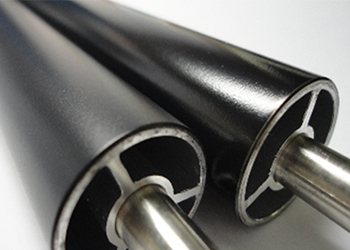Our company can enhance surface characteristics to meet specifications requirements with suitable coating.

Among OA parts, the drive roller for intermediate transfer belt is commonly required to have high coefficient of friction. Our company has come up with a solution, either electrical conductive or non-conductive, to coat an urethane layer on the surface of metal roller to enhance its coefficient of friction.
Besides that, our company also offers fluorine coating service as a solution to prevent various types of liquid contamination (oil water, etc.).
We also offer ceramic coating as a solution to abrasion resistance. In addition, we can apply ceramic coating with beads to reduce friction and abrasion.
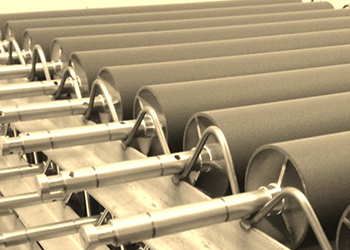
Surface Transformation
As the name suggests, the process of surface transformation is to “transform” the characteristics of a
material “surface”. This process is necessary when a material surface as is cannot meet certain
functional requirement. At Dynaox, we have several options of surface transformation that could meet
specific functional need.
We would like to introduce you to several examples.
1)For the Purpose of Increasing Friction Force (Surface Friction)
This is the case where a material surface is required to have a higher grip force or
higher coefficient of surface friction to prevent or reduce slippage, or to maintain position of a
counter-surface. Handgrip of tennis racket and golf club, sneaker bottom are some examples
we can find in daily objects.
【Application Example at Dynaox】
Intermediate Transfer Belts, or ITBs, are often used in the transfer section of color copy machines.
A ITB Drive Roller is used to supply the force to rotate this belt. A stable friction force is
required of this driver roller to provide a smooth, non-zigzag rotational motion of the belt.
We spray a layer of urethane or urethane foam coating on the surface of our metal roller to meet the
coefficient of friction requirement. The thin layer of urethane and urethane foam coating has tightly
controlled thickness to reduce variability of roller’s outer diameter. Also, urethane is more durable
than rubber thus providing a longer product life.
1. Urethane Coating (Electrical Conductiver or Non-conductive)
Product Photo
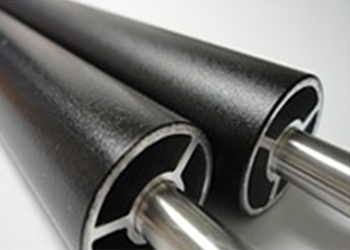
Coating Surface (Magnified)
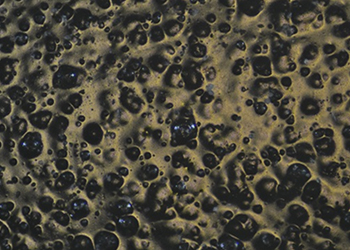
2. Urethane Foam Coating (Electrically Conductive)
Product Photo
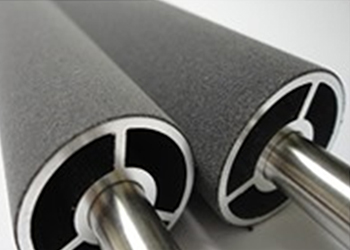
Coating Surface (Magnified)
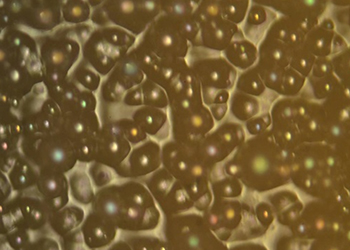
2)Surface Transformation for the Purpose of Rust Prevention
Rust is commonly seen on metal in daily life.
Perhaps we can go as far to say that we cannot have one without the other.
There are many ways to transform a surface for the sake of rust prevention.
One of the most common ones is apply a coat of paint over a metal surface to prevent it from oxidation.
【Application Example at Dynaox】
A metal surface is easily prone to rust especially after it has been machined or grinded.
Thus, oil is often applied on the metal surface afterward for rust prevention purpose.
At Dynaox, we also offer Parkerizing (Phosphating) as another rust prevention option.
Parkerizing is commonly used as a process to add an undercoat or primer to prepare a surface
that will be painted. The Parkerizing process we offer will serve this purpose as well as
yielding the effect of rust-preventative measure concurrently.
The Effects of Rust Prevention from Parkerizing
We compare the state of two metal surfaces, with and without Parkerizing, after they have been
kept together in an environmental controlled room at 23℃, 33% relative humidity for 6 days.
Rust is observable on the metal surface without Parkerizing. Whereas rust is not present on the
metal surface after it has been treated with Parkerizing.
Without Parkerizing
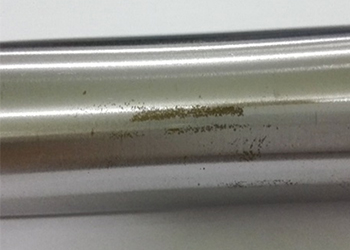
Parkerizing Treated
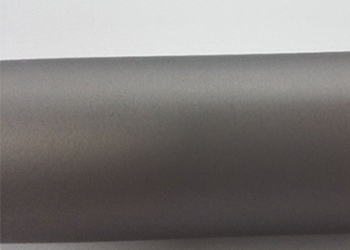
Without Parkerizing (Microscopic Photo)
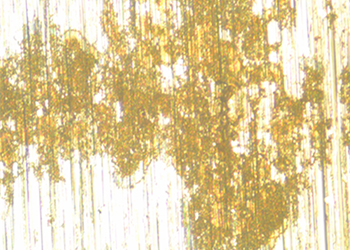
Parkerizing Treated (Microscopic Photo)
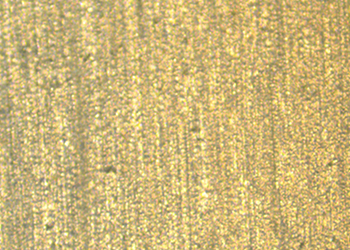
After parts have gone through Parkerizing treatment, we keep them in air-sealed packaging and store them
in environmental controlled storage space before they are delivered to customers.
(Products with Parkerizing Treatment)
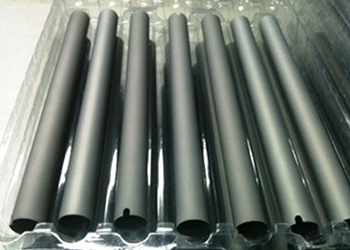
(Temperature and Humidity Controlled Storage)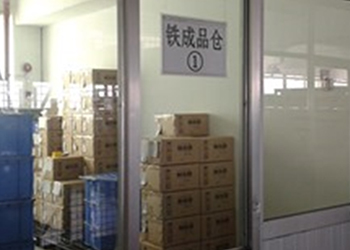
3)Surface Transformation for the Purpose of Thermal Transfer
There are times when the function of thermal transfer is required.
Heat has a natural tendency of travelling from a higher temperature zone to a lower temperature zone.
Thus, a more accurate way to define heat transfer is “to increase the efficiency of the transfer
to allow heat to traverse more easily” across different temperature zones.
It is important to start with a material that already has high thermal transfer characteristic.
We can further increase a material’s thermal transfer rate and thermal absorption rate by transforming its surface.
【Application Example at Dynaox】
The metal core of a Heat Roller in the fusing section of a copy machine is often made from aluminum or steel.
In recent years, copy machines are designed to be eco-friendly by reducing their power consumption.
Characteristics such as low thermal capacity, high thermal transfer rate, thin-wall
(allowing heat to travel faster from the inner surface to the outer surface) are examples of some of
the functions of a Heat Roller to achieve energy saving. Although aluminum provides better thermal
transfer rate than steel, it does not provide the same strength as steel when thin-wall becomes necessary.
| Aluminum | Steel | |
|---|---|---|
| Specific Heat(J/gK) | 0.88 | 0.44 |
| Heat Transfer Rate(W/mK) | 204 | 53 |
Dynaox we are able to process thin-wall steel cores with thickness as low as 0.2mm.
Since it is necessary for Heat Rollers to withstand a high temperature environment,
we can provide Parkerizing process to the core, to form a primer for the top coat, with material
that resists heat. In addition, the inner wall of the core is sprayed with a fluoro-black paint
to increase its thermal absorption.
The inner wall of this roller is sprayed with a heat resistive fluoro-black paint so that it will
absorb heat given off from an inner heater more efficiently. The increase in thermal transfer rate
allows heat to travel faster to the outer surface of the roller.
(Inner Wall Spraying Equipment)

4)Surface Transformation for the Purpose of Increasing Release Characteristic
Perhaps the simplest way to define release characteristic is the ability to not adhering itself
to a counter-material. A common example is the non-stick fluro-based resin coating on the surface
of a frypan. Depending on the application, there are times when our metal rollers are required
to have good release characteristic.
【Application Example at Dynaox】
Fluoro-based coating material has minimal interaction with a counter-material, such as water or oil,
which comes in contact. Thus, it possesses adhesion resistant, moisture resistant and contamination
resistant attributes.
The photo on the left below shows our fluoro-coated roller with an olive oil droplet on its surface.
With fluoro-coating, the olive oil maintains its droplet form and does not run down the surface of the
roller like it would on the surface of the roller without fluoro-coating.
Adding a fluoro-coating to a surface will increase its ability to repel against oil and other fluids
to protect it from stain and contamination. Furthermore, fluoro-coating improves release characteristics
of a surface so that powder or granular materials will not have a tendency to adhere to a coated surface
or can be cleaned away with less effort.
With Fluoro-Coating
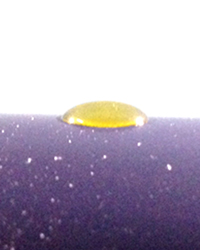
Without Fluoro-Coating
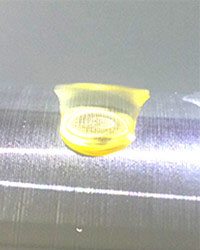
Rollers Developed with Fluoro-Coating (Electrical Conductive and Non-conductive)
